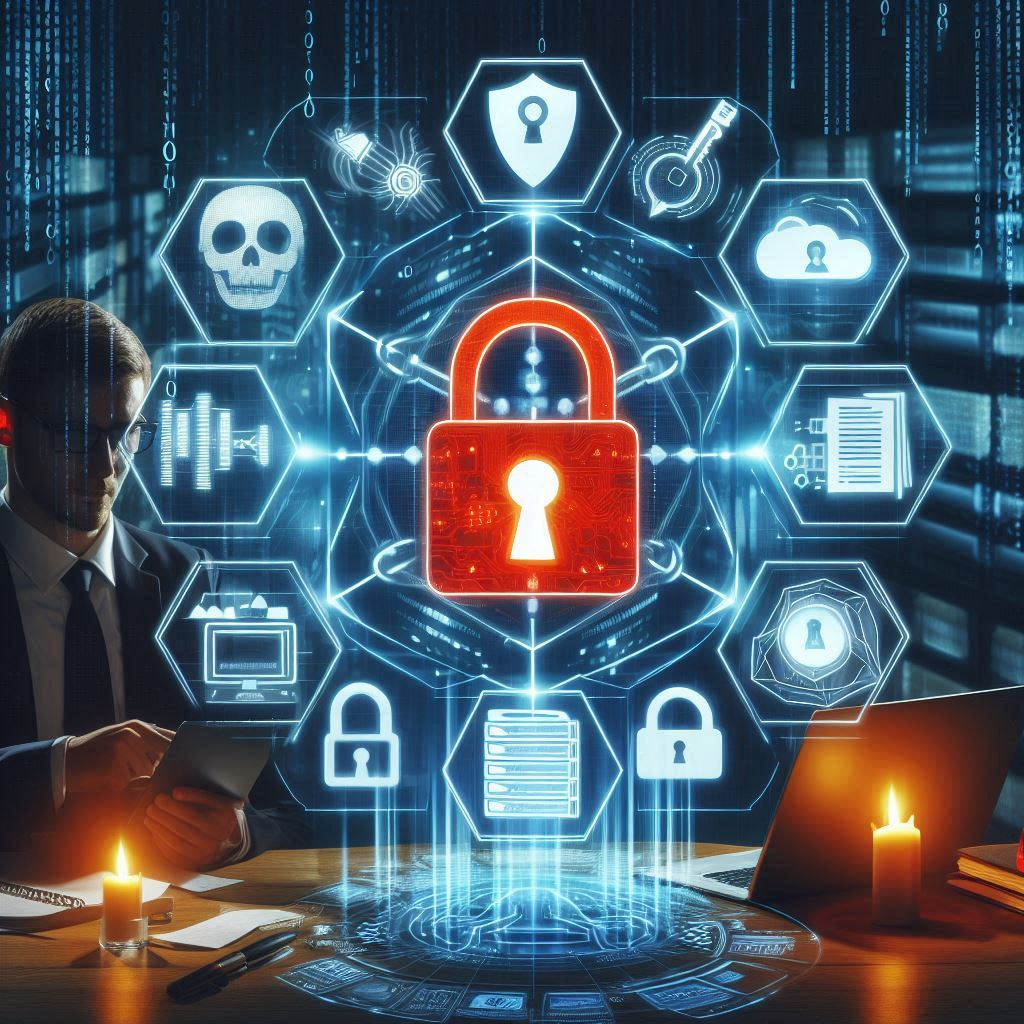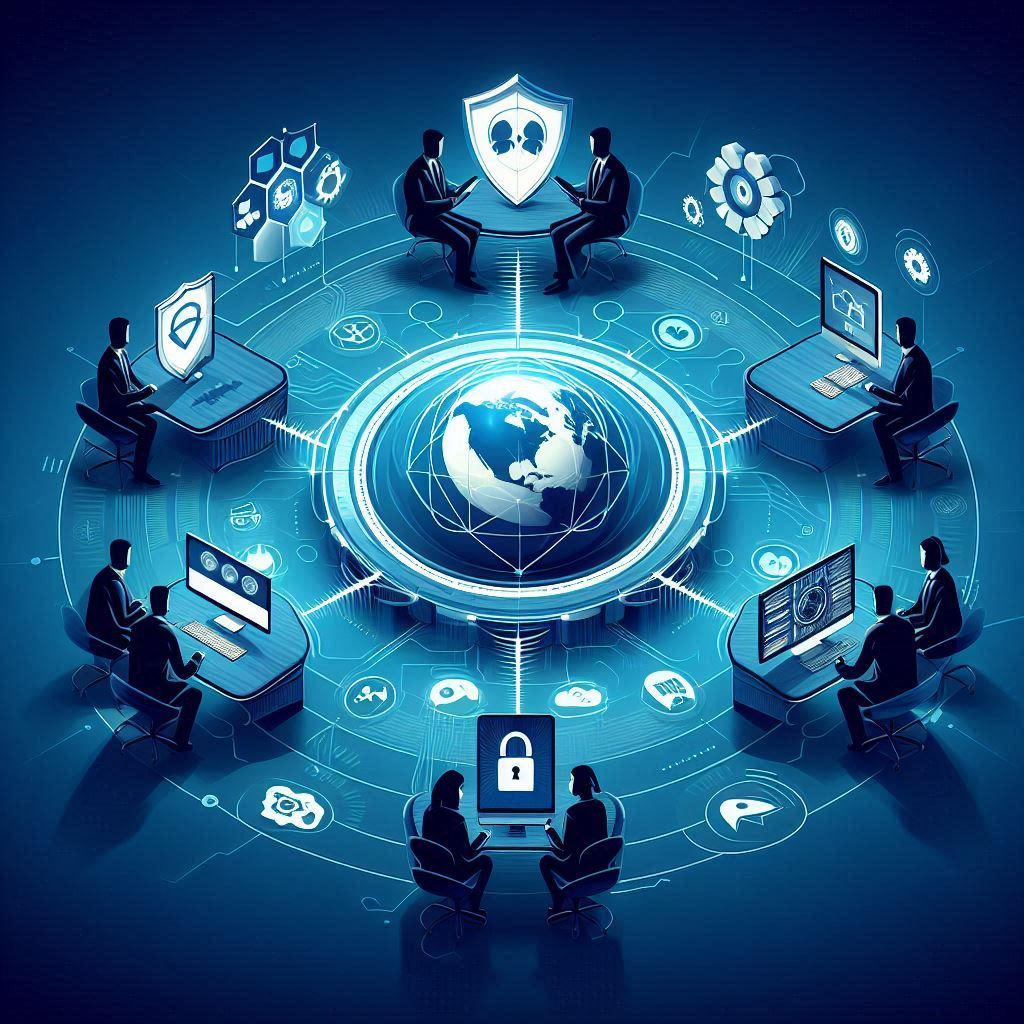Introduction to Ransomware
Ransomware is a type of malicious software designed to block access to a computer system or data until a sum of money is paid. It has become a significant threat in the cybersecurity landscape, evolving from relatively simple beginnings to highly sophisticated attacks. The history of ransomware dates back to the late 1980s, with the first known instance being the “AIDS Trojan” or “PC Cyborg,” which was distributed via floppy disks. Since then, ransomware has evolved dramatically, leveraging advancements in encryption and distribution methods.
There are primarily two types of ransomware: encrypting ransomware and locker ransomware. Encrypting ransomware, as the name suggests, encrypts the victim’s files, rendering them inaccessible. The attacker then demands a ransom for the decryption key. Locker ransomware, on the other hand, locks the user out of their device entirely, making it impossible to access any applications or files. Both types aim to extort money from victims, but they operate in slightly different ways.
Recent years have seen a significant increase in the prevalence and sophistication of ransomware attacks. Attackers are employing more advanced encryption techniques and are often demanding payments in cryptocurrencies, which are harder to trace. The methods of distribution have also become more varied, including phishing emails, malicious advertisements, and exploiting software vulnerabilities. The rising threat of ransomware is evident in the growing number of high-profile attacks on businesses, healthcare institutions, and government agencies.
The increasing sophistication of ransomware threats is a cause for concern. Attackers are not only encrypting data but also exfiltrating it, threatening to release sensitive information publicly if the ransom is not paid. This dual extortion tactic significantly increases the pressure on victims to comply with the demands. As ransomware continues to evolve, it is crucial for businesses to stay informed and take proactive measures to protect their systems and data.
The Impact of Ransomware on Businesses
Ransomware attacks have emerged as one of the most significant cybersecurity threats facing businesses today. The impact of these attacks can be devastating, encompassing financial loss, operational disruption, data breaches, and reputational damage. According to Cybersecurity Ventures, ransomware damages are predicted to cost the world $20 billion in 2021, a stark increase from $325 million in 2015. This alarming trend underscores the growing threat ransomware poses to businesses of all sizes.
Financial loss is often the most immediate and tangible consequence of a ransomware attack. Ransom demands can range from a few thousand dollars to millions, and organizations must also contend with the costs associated with downtime, recovery, and potential regulatory fines. For instance, the WannaCry ransomware attack in 2017 resulted in estimated global damages of up to $4 billion, affecting industries ranging from healthcare to logistics.
Operational disruption is another critical impact. When ransomware infects a network, it can halt business operations entirely. In 2021, Colonial Pipeline, a major fuel pipeline operator in the United States, experienced a ransomware attack that led to a temporary shutdown of operations, causing fuel shortages and significant economic repercussions. Such disruptions can lead to loss of productivity, missed deadlines, and an inability to serve customers.
Data breaches often accompany ransomware attacks, as cybercriminals may exfiltrate sensitive information before encrypting files. This can lead to further complications, including identity theft and intellectual property theft. The healthcare sector, for instance, has been particularly vulnerable, with attacks like the one on Universal Health Services in 2020 exposing patient data and compromising medical services.
Reputational damage is a long-term consequence that can be particularly challenging to recover from. Customers, partners, and stakeholders may lose trust in a business that has fallen victim to a ransomware attack. A study by IBM found that 75% of consumers would not do business with a company they do not trust to protect their data. This loss of confidence can lead to decreased customer loyalty and a tarnished brand image.
The recovery process from a ransomware attack is arduous and time-consuming. Businesses must restore data from backups, implement stronger security measures, and often undergo extensive audits. The long-term consequences can include ongoing legal battles, increased insurance premiums, and a need for continuous investment in cybersecurity.
Traditional security measures, such as antivirus software and firewalls, have long been the cornerstone of cybersecurity. However, in the face of evolving ransomware threats, these tools are increasingly proving to be insufficient. Antivirus software, while effective against known malware, often struggles to identify and neutralize newly emerging ransomware strains. This limitation stems from its reliance on signature-based detection, which is ineffective against sophisticated ransomware that employs polymorphic techniques to constantly change its code.
Firewalls, on the other hand, are designed to prevent unauthorized access to a network by filtering incoming and outgoing traffic. While they are essential for maintaining a secure network perimeter, they fall short when it comes to detecting and blocking ransomware that can enter through legitimate channels, such as phishing emails or compromised websites. Firewalls cannot inspect encrypted traffic deeply, which is a significant limitation given that many ransomware attacks now utilize encryption to evade detection.
Moreover, both antivirus software and firewalls operate on a reactive basis, responding to threats once they have already penetrated the network. This reactive approach is inadequate against the proactive and dynamic nature of modern ransomware attacks. Ransomware can exploit zero-day vulnerabilities and social engineering tactics to bypass traditional security measures, leaving organizations vulnerable to significant financial and reputational damage.
The necessity for more advanced and proactive cybersecurity strategies is evident. Businesses must adopt a multi-layered defense approach that includes endpoint detection and response (EDR), threat intelligence, and continuous monitoring. These advanced measures provide real-time analysis and immediate response to potential threats, significantly reducing the risk of ransomware attacks. Additionally, incorporating regular security awareness training can help employees recognize and avoid phishing attempts, which are a common vector for ransomware.
In today’s threat landscape, relying solely on traditional security measures is no longer sufficient. Organizations must evolve their cybersecurity strategies to stay ahead of sophisticated ransomware threats, ensuring robust protection and resilience against potential attacks.
What Are Managed Security Service Providers (MSSPs)?
Managed Security Service Providers (MSSPs) are specialized organizations dedicated to safeguarding businesses from the ever-evolving landscape of cyber threats. By offering a comprehensive suite of cybersecurity services, MSSPs play a pivotal role in protecting digital assets and ensuring the continuity of business operations. These services include continuous monitoring, threat detection, incident response, and risk management, among others.
One of the foremost responsibilities of MSSPs is continuous monitoring. This involves the real-time surveillance of networks, systems, and applications to identify and mitigate potential threats before they can cause harm. Continuous monitoring ensures that any suspicious activities or anomalies are swiftly detected and addressed, minimizing the risk of a security breach.
In addition to monitoring, MSSPs provide advanced threat detection capabilities. Utilizing state-of-the-art technologies and methodologies, they can identify both known and emerging threats. This proactive approach allows businesses to stay ahead of cybercriminals, reducing the likelihood of successful attacks. The expertise of MSSPs in threat detection is especially critical in today’s environment, where new vulnerabilities and attack vectors are constantly being discovered.
Incident response is another crucial service offered by MSSPs. When a security incident occurs, rapid and effective response is essential to limit damage and restore normal operations. MSSPs have specialized teams trained to handle such incidents, ensuring that the impact is contained and remediation efforts are promptly initiated. Their experience and resources enable a swift recovery, minimizing downtime and financial losses.
Risk management is also a key component of the services provided by MSSPs. They conduct thorough assessments of an organization’s security posture, identifying potential vulnerabilities and recommending strategies to mitigate risks. This proactive approach helps businesses to strengthen their defenses and reduce the likelihood of future incidents.
The expertise and resources that MSSPs bring to the table are invaluable. With a deep understanding of the latest threats and security technologies, they provide businesses with the confidence and assurance needed to operate securely in a digital world. By partnering with an MSSP, organizations can leverage this expertise to enhance their cybersecurity posture and protect against the rising threat of ransomware and other cyber threats.
How MSSPs Can Mitigate Ransomware Threats
Managed Security Service Providers (MSSPs) utilize an array of advanced strategies and technologies to shield businesses from the ever-evolving threat of ransomware. One of the primary methods employed by MSSPs is the use of advanced threat intelligence. By continuously gathering and analyzing data from a variety of sources, MSSPs can stay ahead of potential threats. This proactive approach allows them to identify ransomware indicators early, enabling timely defensive measures.
Another critical component of an MSSP’s defense arsenal is behavioral analysis. Unlike traditional security measures that rely heavily on signature-based detection, behavioral analysis focuses on the actions and patterns of potential threats. By monitoring for unusual behavior within a network, MSSPs can detect and intercept ransomware attacks before they can fully infiltrate systems. This method is particularly effective against zero-day exploits, which may not yet have known signatures.
Real-time monitoring is also essential in the fight against ransomware. MSSPs provide continuous surveillance of an organization’s IT environment, ensuring that any suspicious activity is immediately flagged and investigated. This constant vigilance allows for rapid identification and neutralization of threats, minimizing the potential damage an attack can cause. Real-time monitoring also supports compliance with regulatory requirements, as it ensures that security measures are consistently applied and updated.
Additionally, automated response systems are a cornerstone of an MSSP’s strategy to combat ransomware. These systems can quickly and efficiently respond to detected threats, often without human intervention. Automated responses may include isolating affected systems, deploying patches, or initiating data recovery protocols. This rapid reaction capability is crucial in limiting the spread of ransomware and reducing downtime for affected businesses.
By leveraging these sophisticated tools and methodologies, MSSPs can effectively identify, neutralize, and mitigate ransomware threats. Their proactive and comprehensive approach ensures that businesses are better protected against the potentially devastating impacts of ransomware attacks.
Case Studies: MSSPs in Action Against Ransomware
In recent years, Managed Security Service Providers (MSSPs) have played a pivotal role in safeguarding businesses from the ever-evolving threat of ransomware. These real-world examples illustrate how MSSPs have successfully intercepted and mitigated ransomware attacks, underscoring their critical value in today’s cybersecurity landscape.
One notable case involves a mid-sized healthcare organization that faced a sophisticated ransomware attack. The attackers had infiltrated the network through a phishing email, encrypting sensitive patient data and demanding a substantial ransom. The healthcare provider, recognizing the severity of the breach, quickly enlisted the help of their MSSP. The MSSP immediately deployed advanced threat detection tools to isolate the infected systems, preventing further spread of the malware. Through meticulous forensic analysis, the MSSP identified the entry point and the specific strain of ransomware. They then initiated a comprehensive data recovery process, leveraging secure backups to restore the encrypted files. The healthcare provider’s operations were swiftly brought back online, and the incident highlighted the importance of proactive threat monitoring and robust backup solutions.
Another case study features a global manufacturing firm that encountered a ransomware attack targeting their industrial control systems. The attackers aimed to disrupt production lines and extort a hefty ransom. The MSSP managing the firm’s cybersecurity swiftly responded by deploying an incident response team on-site. Utilizing their expertise in industrial cybersecurity, the MSSP isolated the critical systems and initiated a containment strategy. They collaborated with the firm’s IT team to patch vulnerabilities and enhance network segmentation. Additionally, the MSSP conducted a comprehensive threat hunt to ensure no residual malware remained. The firm’s production was restored with minimal downtime, emphasizing the effectiveness of a coordinated, multi-layered defense approach.
A third example involves a financial services company that experienced a ransomware attack during a critical business period. The MSSP detected unusual network activity through continuous monitoring and quickly alerted the company’s IT department. Upon confirming the presence of ransomware, the MSSP implemented an incident response plan, which included network isolation, malware eradication, and system restoration. Their swift action and expertise not only prevented significant data loss but also maintained the company’s reputation among clients and stakeholders.
These case studies demonstrate the indispensable role of MSSPs in combating ransomware. They showcase how proactive threat detection, rapid incident response, and comprehensive recovery strategies can effectively mitigate the impact of ransomware attacks, ensuring business continuity and data integrity.
Choosing the Right MSSP for Your Business
Selecting the appropriate Managed Security Service Provider (MSSP) is crucial for ensuring the robust protection of your business against ransomware and other cyber threats. When evaluating potential MSSPs, there are several key criteria to consider to make an informed decision that aligns with your organization’s specific needs.
First, assess the expertise of the MSSP. A reputable provider should have a proven track record in cybersecurity and extensive experience dealing with ransomware. Look for certifications and partnerships with leading cybersecurity vendors, as these can be indicators of the provider’s competence and commitment to staying updated with the latest security trends.
Next, examine the service offerings of the MSSP. Ensure that they provide comprehensive security solutions, including threat detection, incident response, and continuous monitoring. It’s also important to verify that they offer advanced technologies such as artificial intelligence (AI) and machine learning (ML) to enhance threat detection capabilities. A robust technology stack is essential for maintaining a proactive security posture.
Customer support is another critical factor. Effective and responsive support can make a significant difference in mitigating the impact of a ransomware attack. Evaluate the MSSP’s support structure, including the availability of 24/7 assistance and the presence of dedicated security analysts. Additionally, check for customer reviews and testimonials to gauge the provider’s reliability and responsiveness.
Furthermore, consider the MSSP’s reputation in the industry. Research their history, client base, and any industry accolades or recognition they may have received. A well-regarded MSSP is more likely to deliver high-quality services and maintain strong ethical standards.
Finally, when evaluating potential MSSPs, request detailed proposals and conduct thorough interviews. Ask for case studies or examples of how they have successfully protected other businesses from ransomware attacks. This will provide insights into their practical experience and effectiveness. By carefully considering these factors, you can choose an MSSP that will offer robust protection and peace of mind for your business.
Conclusion: The Future of Ransomware and MSSP Protection
Throughout this article, we have explored the escalating threat of ransomware and the indispensable role that Managed Security Service Providers (MSSPs) play in mitigating these risks. Ransomware attacks have evolved in sophistication and frequency, making it imperative for businesses to adopt proactive and comprehensive security measures. MSSPs provide an essential line of defense, offering specialized knowledge, advanced detection technologies, and timely response strategies that are crucial in today’s cyber threat landscape.
As ransomware continues to evolve, so too must the approaches to combat it. MSSPs are at the forefront of this battle, continuously adapting their services to address new and emerging threats. Their ability to provide real-time monitoring, threat intelligence, and incident response is vital for minimizing the damage caused by ransomware attacks. Moreover, the integration of artificial intelligence and machine learning into MSSP services is set to enhance their capability to predict and neutralize threats before they can inflict harm.
The future of ransomware protection will likely see a greater emphasis on collaborative efforts between MSSPs and businesses. This partnership ensures a cohesive and resilient defense mechanism, tailored to the specific needs of each organization. Additionally, the implementation of robust backup solutions, regular security training for employees, and stringent access controls are essential practices that MSSPs can help businesses enforce.
In conclusion, the rising threat of ransomware necessitates a vigilant and proactive stance. Businesses must recognize the critical importance of MSSPs in safeguarding their operations against these malicious attacks. By staying informed about the latest trends in ransomware and leveraging the expertise of MSSPs, organizations can better protect themselves and ensure their long-term security and resilience in an increasingly digital world.



